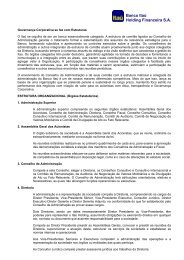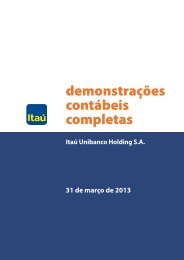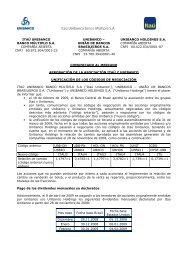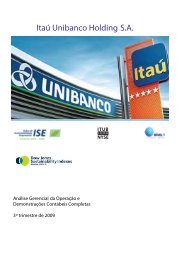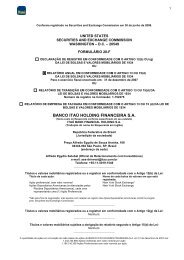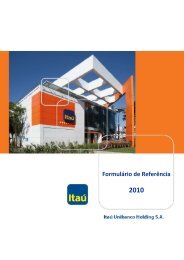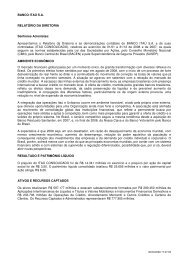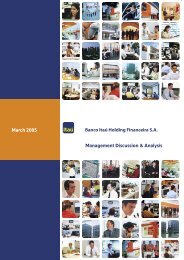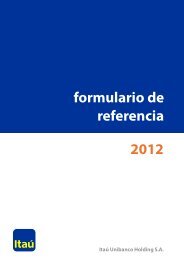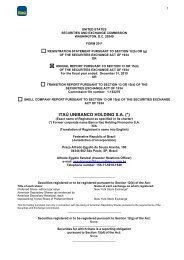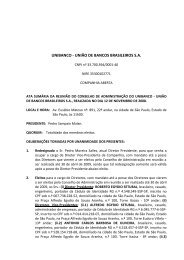Relationships - Banco Itaú
Relationships - Banco Itaú
Relationships - Banco Itaú
Create successful ePaper yourself
Turn your PDF publications into a flip-book with our unique Google optimized e-Paper software.
Corporate Governance<br />
With the significant diversification of risks by<br />
our business units, the Organization maintains<br />
a reduced overall exposure to market risk, when<br />
compared with its capital.<br />
Liquidity Risk<br />
Liquidity risk is designed to detect imbalances<br />
between negotiable assets and payable<br />
liabilities, or when there is a mismatch<br />
between payments and receipts that might<br />
affect our payment capability, considering the<br />
different currencies and settlement terms for<br />
rights and obligations.<br />
Liquidity risk management uses best<br />
practices to avoid cash shortages and<br />
difficulties in honouring payments due.<br />
We have established guidelines and limits,<br />
and compliance is regularly reviewed by<br />
technical committees designed to ensure<br />
an additional safety margin beyond the<br />
minimum projected security needs. Liquidity<br />
management policies and their associated<br />
limits are established based on periodically<br />
reviewed prospective scenarios, and on the<br />
limits set by the Senior Institutional Treasury<br />
Liquidity Commission.<br />
Operational Risk<br />
Operational risk is the risk of loss resulting<br />
from inadequate or failed internal processes,<br />
people and systems, or from external<br />
events. This category also includes legal risks<br />
associated with inadequate or incomplete<br />
contracts, as well as penalties incurred due<br />
to non-compliance with legal provisions and<br />
compensation for damages to third parties<br />
arising from our activities.<br />
During the <strong>Itaú</strong> Unibanco merger process,<br />
for example, operational risks are carefully<br />
monitored once they become part of the<br />
migration of branches and systems.<br />
Under our integrated operational risk<br />
management policy, approved by the Board<br />
of Directors, we have adopted all Central Bank<br />
requirements with respect to operational risk<br />
management, pursuant to CMN Resolution<br />
3380 of June 2006, which is based on the<br />
principles and good practices of Basel II.<br />
The operational risk management governance<br />
structure is made up of the Board of<br />
Directors, the Audit Committee, Internal<br />
Audit, the President’s Office plus Executive<br />
Officers and Related Technical Risk areas. This<br />
structure is responsible for the operational<br />
risk management process, which includes<br />
four phases: identification, evaluation,<br />
management and monitoring.<br />
We employ management models for financial<br />
evaluation by business line, quantifying<br />
operational risks incurred by using statistical<br />
models that allow provisioning of reserves<br />
for expected losses and allocation of capital<br />
for unexpected losses. This gives us a more<br />
refined pricing process for products and<br />
services offered to the market, and follows the<br />
criteria of the Basel II Capital Accord, within<br />
the timeframes set by the regulator.<br />
Underwriting Risk<br />
Underwriting risk is applicable to insurance<br />
companies and is associated with the<br />
probability of decision errors in determining<br />
the price and/or calculation of technical<br />
reserves for insurance products, as well as in<br />
monitoring the decisions made. Similar to<br />
Basel II + , the International Association of<br />
Insurance Supervisors (IAIS) guides insurance<br />
companies on employing risk management<br />
systems which supplement their minimum<br />
capital and solvency margin systems.<br />
Our team specializes in underwriting risk<br />
analysis and control for insurance products,<br />
and builds mathematical models that<br />
capture such risks in the proper allocation of<br />
managerial capital.<br />
Market Risk Indicators<br />
The following Value at Risk table consolidates<br />
<strong>Itaú</strong> Unibanco’s total VaR, covering the<br />
portfolios of: <strong>Itaú</strong> BBA, <strong>Banco</strong> <strong>Itaú</strong> Europa,<br />
<strong>Banco</strong> <strong>Itaú</strong> Argentina, <strong>Banco</strong> <strong>Itaú</strong> Chile and<br />
<strong>Banco</strong> <strong>Itaú</strong> Uruguay. The portfolios of <strong>Itaú</strong><br />
Unibanco S.A. and <strong>Itaú</strong> BBA are grouped<br />
together, separated by risk factor.<br />
+ Basel II Capital Accord – Replaces the Basel I agreement which was signed in the Swiss city of Basel in 1988. The new accord was ratified by more<br />
than 100 countries and seeks to establish minimum capital requirements to be held by commercial banks as a precaution against credit risk. Basel II<br />
is built on three pillars: Capital (save); Supervision, (inspect) and Transparency and Market Discipline (disclose), in addition to 25 basic accounting and<br />
supervision principles.<br />
36 <strong>Itaú</strong> Unibanco Holding S.A.



